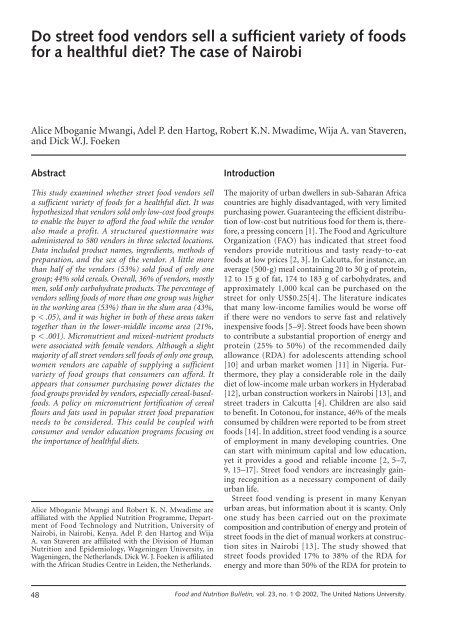F&N Bulletin Vol 23 No 1b - United Nations University
F&N Bulletin Vol 23 No 1b - United Nations University
F&N Bulletin Vol 23 No 1b - United Nations University
You also want an ePaper? Increase the reach of your titles
YUMPU automatically turns print PDFs into web optimized ePapers that Google loves.
Do street food vendors sell a sufficient variety of foods<br />
for a healthful diet? The case of Nairobi<br />
Alice Mboganie Mwangi, Adel P. den Hartog, Robert K.N. Mwadime, Wija A. van Staveren,<br />
and Dick W.J. Foeken<br />
Abstract<br />
This study examined whether street food vendors sell<br />
a sufficient variety of foods for a healthful diet. It was<br />
hypothesized that vendors sold only low-cost food groups<br />
to enable the buyer to afford the food while the vendor<br />
also made a profit. A structured questionnaire was<br />
administered to 580 vendors in three selected locations.<br />
Data included product names, ingredients, methods of<br />
preparation, and the sex of the vendor. A little more<br />
than half of the vendors (53%) sold food of only one<br />
group; 44% sold cereals. Overall, 36% of vendors, mostly<br />
men, sold only carbohydrate products. The percentage of<br />
vendors selling foods of more than one group was higher<br />
in the working area (53%) than in the slum area (43%,<br />
p < .05), and it was higher in both of these areas taken<br />
together than in the lower-middle income area (21%,<br />
p < .001). Micronutrient and mixed-nutrient products<br />
were associated with female vendors. Although a slight<br />
majority of all street vendors sell foods of only one group,<br />
women vendors are capable of supplying a sufficient<br />
variety of food groups that consumers can afford. It<br />
appears that consumer purchasing power dictates the<br />
food groups provided by vendors, especially cereal-basedfoods.<br />
A policy on micronutrient fortification of cereal<br />
flours and fats used in popular street food preparation<br />
needs to be considered. This could be coupled with<br />
consumer and vendor education programs focusing on<br />
the importance of healthful diets.<br />
Alice Mboganie Mwangi and Robert K. N. Mwadime are<br />
affiliated with the Applied Nutrition Programme, Department<br />
of Food Technology and Nutrition, <strong>University</strong> of<br />
Nairobi, in Nairobi, Kenya. Adel P. den Hartog and Wija<br />
A. van Staveren are affiliated with the Division of Human<br />
Nutrition and Epidemiology, Wageningen <strong>University</strong>, in<br />
Wageningen, the Netherlands. Dick W. J. Foeken is affiliated<br />
with the African Studies Centre in Leiden, the Netherlands.<br />
Introduction<br />
The majority of urban dwellers in sub-Saharan Africa<br />
countries are highly disadvantaged, with very limited<br />
purchasing power. Guaranteeing the efficient distribution<br />
of low-cost but nutritious food for them is, therefore,<br />
a pressing concern [1]. The Food and Agriculture<br />
Organization (FAO) has indicated that street food<br />
vendors provide nutritious and tasty ready-to-eat<br />
foods at low prices [2, 3]. In Calcutta, for instance, an<br />
average (500-g) meal containing 20 to 30 g of protein,<br />
12 to 15 g of fat, 174 to 183 g of carbohydrates, and<br />
approximately 1,000 kcal can be purchased on the<br />
street for only US$0.25[4]. The literature indicates<br />
that many low-income families would be worse off<br />
if there were no vendors to serve fast and relatively<br />
inexpensive foods [5–9]. Street foods have been shown<br />
to contribute a substantial proportion of energy and<br />
protein (25% to 50%) of the recommended daily<br />
allowance (RDA) for adolescents attending school<br />
[10] and urban market women [11] in Nigeria. Furthermore,<br />
they play a considerable role in the daily<br />
diet of low-income male urban workers in Hyderabad<br />
[12], urban construction workers in Nairobi [13], and<br />
street traders in Calcutta [4]. Children are also said<br />
to benefit. In Cotonou, for instance, 46% of the meals<br />
consumed by children were reported to be from street<br />
foods [14]. In addition, street food vending is a source<br />
of employment in many developing countries. One<br />
can start with minimum capital and low education,<br />
yet it provides a good and reliable income [2, 5–7,<br />
9, 15–17]. Street food vendors are increasingly gaining<br />
recognition as a necessary component of daily<br />
urban life.<br />
Street food vending is present in many Kenyan<br />
urban areas, but information about it is scanty. Only<br />
one study has been carried out on the proximate<br />
composition and contribution of energy and protein of<br />
street foods in the diet of manual workers at construction<br />
sites in Nairobi [13]. The study showed that<br />
street foods provided 17% to 38% of the RDA for<br />
energy and more than 50% of the RDA for protein to<br />
48 Food and Nutrition <strong>Bulletin</strong>, vol. <strong>23</strong>, no. 1 © 2002, The <strong>United</strong> <strong>Nations</strong> <strong>University</strong>.
















